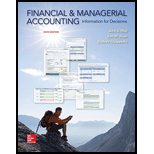
Financial and Managerial Accounting: Information for Decisions
6th Edition
ISBN: 9780078025761
Author: John J Wild, Ken Shaw Accounting Professor, Barbara Chiappetta Fundamental Accounting Principles
Publisher: McGraw-Hill Education
expand_more
expand_more
format_list_bulleted
Concept explainers
Textbook Question
Chapter 3, Problem 2E
Exercise 3-2 Adjusting and paying accrued expenses P1
The following three separate situations require adjusting
- The April 30
adjusting entry. - The subsequent entry during May to record payment of the accrued expenses
Entries can draw from the following partial chart of accounts. Cash;
- On April 1, the company retained an attorney for a flat monthly fee of $3,500. Payment for April legal services was made by the company on May 12.
- A $900.000 note payable requires 12% annual interest, or $9.000, to be paid at the 20th day of each month. The interest was last paid on April 20, and the next payment is due on May 20. As of April 30. $3.000 of interest expense has accrued. Check ( b ) May 20 Dr. Interest Expense, $6,000
- Total weekly salaries expense for all employees is $10,000. This amount is paid at the end of the day on Friday of each five-day workweek. April 30 falls on a Tuesday, which means that the employees had worked two days since the last payday. The next payday is May 3.
Expert Solution & Answer
Want to see the full answer?
Check out a sample textbook solution
Students have asked these similar questions
need help this questions
What is the monthly break even in total dollar sales?
General accounting
Chapter 3 Solutions
Financial and Managerial Accounting: Information for Decisions
Ch. 3 - Prob. 1MCQCh. 3 - Prior to recording adjusting entries, the Supplies...Ch. 3 - Prob. 3MCQCh. 3 - Prob. 4MCQCh. 3 - If a company had $ 15,000 in net income for the...Ch. 3 - What is the difference between the cash basis and...Ch. 3 - Why is the accrual basis of accounting generally...Ch. 3 - What type of business is most likely to select a...Ch. 3 - Prob. 4DQCh. 3 - Prob. 5DQ
Ch. 3 - Prob. 6DQCh. 3 - Prob. 7DQCh. 3 - Prob. 8DQCh. 3 - A If a company initially records prepaid expenses...Ch. 3 - Prob. 10DQCh. 3 - Prob. 11DQCh. 3 - Prob. 12DQCh. 3 - Prob. 13DQCh. 3 - Prob. 14DQCh. 3 - Prob. 15DQCh. 3 - Prob. 16DQCh. 3 - Prob. 17DQCh. 3 - Prob. 18DQCh. 3 - Prob. 19DQCh. 3 - Prob. 20DQCh. 3 - Prob. 21DQCh. 3 - Prob. 22DQCh. 3 - Prob. 23DQCh. 3 - Prob. 24DQCh. 3 - Prob. 25DQCh. 3 - Prob. 26DQCh. 3 - Prob. 27DQCh. 3 - Prob. 28DQCh. 3 - Prob. 29DQCh. 3 - Periodic reporting C1 Choose from the following...Ch. 3 - Computing accrual and cash income C1 In its first...Ch. 3 - Identifying accounting adjustments P1 Classify the...Ch. 3 - Prob. 4QSCh. 3 - Prepaid (deferred) expenses adjustments P1 For...Ch. 3 - Prepaid (deferred) expense adjustments P1 For each...Ch. 3 - Prob. 7QSCh. 3 - Prob. 8QSCh. 3 - Prob. 9QSCh. 3 - Prob. 10QSCh. 3 - Prob. 11QSCh. 3 - Prob. 12QSCh. 3 - Prob. 13QSCh. 3 - Prob. 14QSCh. 3 - Recording and analyzing adjusting entries P1...Ch. 3 - Prob. 16QSCh. 3 - Prob. 17QSCh. 3 - Prob. 18QSCh. 3 - Prob. 19QSCh. 3 - A preparing adjusting entries P4 Cal Consulting...Ch. 3 - Preparing closing entries from the ledger P4 The...Ch. 3 - Identifying post-closing accounts P5 Identify...Ch. 3 - identifying the accounting cycle C2 List the...Ch. 3 - Classifying balance sheet items C3 The following...Ch. 3 - Identifying current accounts and computing the...Ch. 3 - Prob. 26QSCh. 3 - Prob. 27QSCh. 3 - Prob. 1ECh. 3 - Exercise 3-2 Adjusting and paying accrued expenses...Ch. 3 - Prob. 3ECh. 3 - Prob. 4ECh. 3 - Prob. 5ECh. 3 - Prob. 6ECh. 3 - Prob. 7ECh. 3 - Prob. 8ECh. 3 - Prob. 9ECh. 3 - Prob. 10ECh. 3 - Prob. 11ECh. 3 - Prob. 12ECh. 3 - Prob. 13ECh. 3 - Prob. 14ECh. 3 - Prob. 15ECh. 3 - Prob. 1PSACh. 3 - Prob. 2PSACh. 3 - Prob. 3PSACh. 3 - Prob. 4PSACh. 3 - Prob. 5PSACh. 3 - Prob. 6PSACh. 3 - Prob. 7PSACh. 3 - Prob. 8PSACh. 3 - Prob. 1PSBCh. 3 - Prob. 2PSBCh. 3 - Prob. 3PSBCh. 3 - Prob. 4PSBCh. 3 - Prob. 5PSBCh. 3 - Prob. 6PSBCh. 3 - Prob. 7PSBCh. 3 - Prob. 8PSBCh. 3 - Prob. 3SPCh. 3 - Prob. 1GLPCh. 3 - Prob. 2GLPCh. 3 - Prob. 3GLPCh. 3 - Prob. 4GLPCh. 3 - Prob. 5GLPCh. 3 - Prob. 6GLPCh. 3 - Prob. 1BTNCh. 3 - Prob. 2BTNCh. 3 - Prob. 3BTNCh. 3 - Prob. 4BTNCh. 3 - Prob. 5BTNCh. 3 - Prob. 6BTNCh. 3 - Prob. 7BTNCh. 3 - Prob. 8BTNCh. 3 - Prob. 9BTN
Knowledge Booster
Learn more about
Need a deep-dive on the concept behind this application? Look no further. Learn more about this topic, accounting and related others by exploring similar questions and additional content below.Similar questions
arrow_back_ios
SEE MORE QUESTIONS
arrow_forward_ios
Recommended textbooks for you
- Century 21 Accounting Multicolumn JournalAccountingISBN:9781337679503Author:GilbertsonPublisher:Cengage
 College Accounting, Chapters 1-27AccountingISBN:9781337794756Author:HEINTZ, James A.Publisher:Cengage Learning,
College Accounting, Chapters 1-27AccountingISBN:9781337794756Author:HEINTZ, James A.Publisher:Cengage Learning,  College Accounting, Chapters 1-27 (New in Account...AccountingISBN:9781305666160Author:James A. Heintz, Robert W. ParryPublisher:Cengage Learning
College Accounting, Chapters 1-27 (New in Account...AccountingISBN:9781305666160Author:James A. Heintz, Robert W. ParryPublisher:Cengage Learning Survey of Accounting (Accounting I)AccountingISBN:9781305961883Author:Carl WarrenPublisher:Cengage Learning
Survey of Accounting (Accounting I)AccountingISBN:9781305961883Author:Carl WarrenPublisher:Cengage Learning

Century 21 Accounting Multicolumn Journal
Accounting
ISBN:9781337679503
Author:Gilbertson
Publisher:Cengage


College Accounting, Chapters 1-27
Accounting
ISBN:9781337794756
Author:HEINTZ, James A.
Publisher:Cengage Learning,

College Accounting, Chapters 1-27 (New in Account...
Accounting
ISBN:9781305666160
Author:James A. Heintz, Robert W. Parry
Publisher:Cengage Learning

Survey of Accounting (Accounting I)
Accounting
ISBN:9781305961883
Author:Carl Warren
Publisher:Cengage Learning
The accounting cycle; Author: Alanis Business academy;https://www.youtube.com/watch?v=XTspj8CtzPk;License: Standard YouTube License, CC-BY